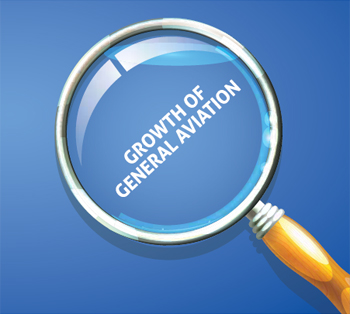Proportionate Safety Regulations to Optimise Growth of GA Industry in India
Reclassification of AT operations, and framing of proportionate safety regulations for smaller aircrafts, is an issue which needs to be addressed at the topmost priority to let our nation reap the full benefit of ambitious plans of civil aviation ministry to connect every nook and corner of India through air.

When India got recognised as one of the fastest growing economy in the world, ICAO felt it was the time to conduct a thorough study to help the government focus on optimising growth of General Aviation (GA) industry in India. This study conducted in 2012 was based on wider concept of GA industry as defined by National Business Association of USA (NBAA), which encompasses all civil aviation activities except that of commercial airlines operating bigger aircraft and, the military aviation. Developed nations today have more than 80 per cent of global GA fleet to connect every nook and corner of the country and, if India aspires to join the group of developed nations in future it too has to work for optimising growth of GA industry in the country. Based on previous world-wide trends in developed nations, the ICAO’s study report had forecasted GA fleet to grow at average rate of between 8 to 10 per cent till the year 2021 and then moderate to around 4 to 6 per cent till the year 2036. This would have meant the country’s fleet to expand from around 900 aircrafts in 2012 to more than 4,000 aircrafts in 2036. However, the strength GA fleet in the last six years has remained unchanged and, sometimes showing even negative growth, especially the helicopter industry.

The above calls for immediate attention of the policy makers in India as GA industry has proved to be a big enabler of growth and prosperity in the developed nations. The National Civil Aviation Policy (NCAP) 2016 was majorly focussed on Regional Connectivity Scheme (RCS) to lend support in the form of Viability Gap Funding (VGF) to small, less than 80 seats capacity, aircrafts for providing air connectivity to hitherto unserved/underserved smaller cities and towns. However, for RCS to achieve full measure of success, the fundamental reasons for stagnant GA industry in Indiawould have to be addressed first. Though lack of dedicated infrastructure and taxation regime have been adversely affecting growth of GA industry, the major reason for stunted growth of GA industry has been the absence of graded or proportionate safety regulations in India. BAOA had raised this issue with civil aviation ministry in July 2014 and made a strong plea to follow policy of framing own domestic regulations, most suited for the country, as is being followed by USA (FAA) and Europe (EASA) for decades, to enable growth of domestic aviation in remote areas. The International Civil Aviation Organisation (ICAO) restricts itself to mandating a general framework of regulations, as Standard & Recommended Practices (SARPs), most suited to international operations by airlines. Developed nations, with focus on domestic regional/remote air connectivity, frame own safety regulations by duly and adequately mitigating any risk to domestic operations, within the overall framework of ICAO’s SARPs. This results in graded approach practiced by developed nations, giving due consideration to airframe-engine combination and weight of the aircraft.
Developed nations today have more than 80 per cent of global GA fleet to connect every nook and corner of the country and, if India aspires to join the group of developed nations in future it too has to work for optimising growth of GA industry in the country.
In India, the DGCA’s CARs, though compliant with relevant annexures and SARPs of ICAO, are not having graded regulatory structure that takes into consideration the combination of airframe, engine, passenger seating capacity, frequency of operations and, the commercial, taxation and financial aspects. Indian classification of ‘air transport’ (AT) operations draws on the Aircraft Rules 1937, with broad delineation between commercial and non-commercial operations. However, within commercial operations there are no SARPs for scheduled, commuter and non-scheduled operations. The different SARPs for larger aircraft with higher ‘all up weight’ (AUW) essentially recognise the higher passenger seating capacity and/or the increased range of the aircraft. FAA and EASA follow graded or proportionate approach to rule making and categorisation of AT operations and allow flexibility in safety regulations, depending upon the complexity of the aircraft, within the overall framework of ICAO’s SARPs. The current classification of AT operations in India, though in harmony with ICAO, are at variance with best international practices. The Indian safety regulations for certification of operators and the governing operating/training/licensing regulations are fragmented compared to FAA and EASA. This leads to bottlenecks and inadequate clarity for small aircraft operators, as well as for regulator to some extent, due to varied certification regulations for a common set of operating regulations.
Reclassification of AT operations, and framing of proportionate safety regulations for smaller aircrafts, is an issue which needs to be addressed at the topmost priority to let our nation reap the full benefit of ambitious plans of civil aviation ministry to connect every nook and corner of India through air. The objective should be to make the AT classification, with attendant regulations, more realistic, rational and ‘user friendly’.
Author is Group Captain (Retd), IAF





